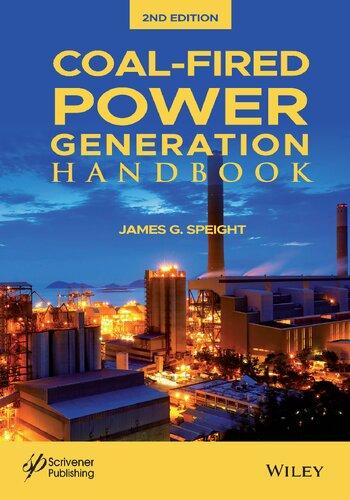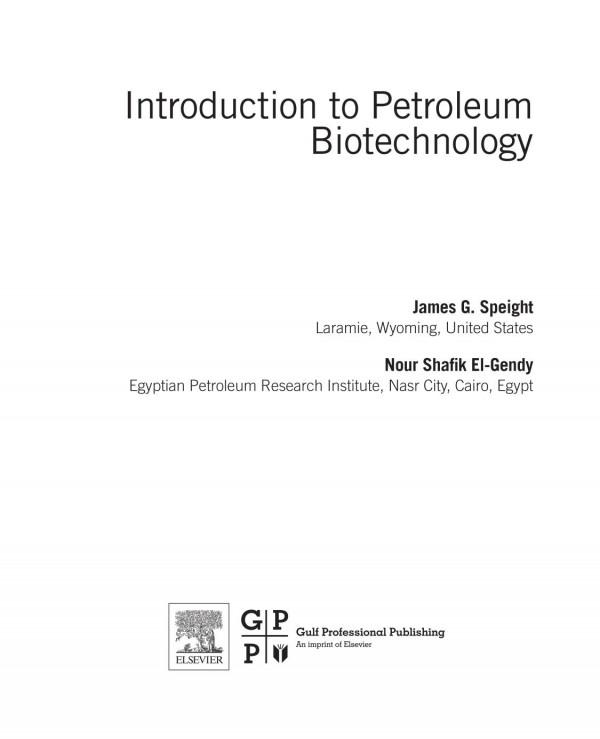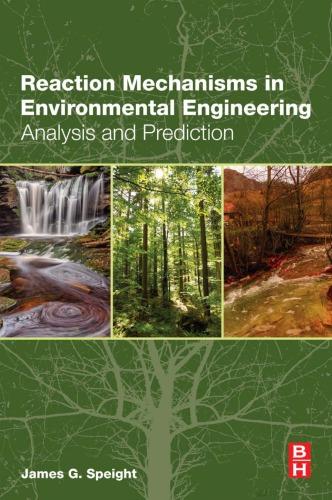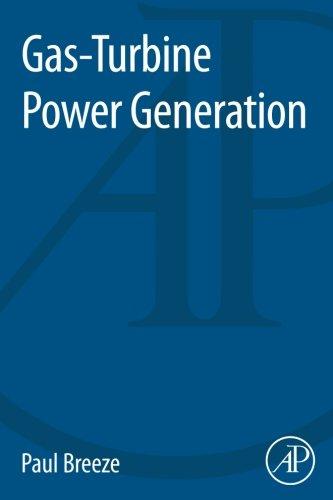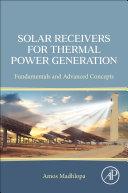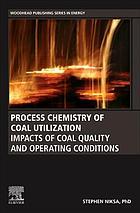Coal-Fired Power Generation Handbook
James G. Speight
Visit to download the full and correct content document: https://ebookmass.com/product/coal-fired-power-generation-handbook-james-g-speig ht/
More products digital (pdf, epub, mobi) instant download maybe you interests ...
Synthesis Gas James G. Speight
https://ebookmass.com/product/synthesis-gas-james-g-speight/
Handbook of Gasification Technology: Science, Processes, and Applications James G. Speight
https://ebookmass.com/product/handbook-of-gasificationtechnology-science-processes-and-applications-james-g-speight/
Introduction to Petroleum Biotechnology 1st Edition James G. Speight
https://ebookmass.com/product/introduction-to-petroleumbiotechnology-1st-edition-james-g-speight/
Handbook of Industrial Hydrocarbon Processes 2nd Edition James Speight
https://ebookmass.com/product/handbook-of-industrial-hydrocarbonprocesses-2nd-edition-james-speight/
Reaction Mechanisms in Environmental Engineering. Analysis and Prediction James G. Speight
https://ebookmass.com/product/reaction-mechanisms-inenvironmental-engineering-analysis-and-prediction-james-gspeight/
Gas-Turbine Power Generation 1st Edition Breeze
https://ebookmass.com/product/gas-turbine-power-generation-1stedition-breeze/
Solar Receivers for Thermal Power Generation Amos Madhlopa
https://ebookmass.com/product/solar-receivers-for-thermal-powergeneration-amos-madhlopa/
Fundamentals of Thermal and Nuclear Power Generation Yasuo Koizumi (Editor)
https://ebookmass.com/product/fundamentals-of-thermal-andnuclear-power-generation-yasuo-koizumi-editor/
Process chemistry of coal utilization : impacts of coal quality and operating conditions Stephen Niksa
https://ebookmass.com/product/process-chemistry-of-coalutilization-impacts-of-coal-quality-and-operating-conditionsstephen-niksa/
Scrivener Publishing
100 Cummings Center, Suite 541J Beverly, MA 01915-6106
Publishers at Scrivener
Martin Scrivener (martin@scrivenerpublishing.com)
Phillip Carmical (pcarmical@scrivenerpublishing.com)
James G. Speight
This edition first published 2021 by John Wiley & Sons, Inc., 111 River Street, Hoboken, NJ 07030, USA and Scrivener Publishing LLC, 100 Cummings Center, Suite 541J, Beverly, MA 01915, USA
© 2021 Scrivener Publishing LLC
For more information about Scrivener publications please visit www.scrivenerpublishing.com.
All rights reserved. No part of this publication may be reproduced, stored in a retrieval system, or transmitted, in any form or by any means, electronic, mechanical, photocopying, recording, or otherwise, except as permitted by law. Advice on how to obtain permission to reuse material from this title is available at http://www.wiley.com/go/permissions.
Wiley Global Headquarters
111 River Street, Hoboken, NJ 07030, USA
For details of our global editorial offices, customer services, and more information about Wiley prod-ucts visit us at www. wiley.com.
Limit of Liability/Disclaimer of Warranty
While the publisher and authors have used their best efforts in preparing this work, they make no representations or warranties with respect to the accuracy or completeness of the contents of this work and specifically disclaim all warranties, including without limitation any implied warranties of merchant-ability or fitness for a particular purpose. No warranty may be created or extended by sales representatives, written sales materials, or promotional statements for this work. The fact that an organization, website, or product is referred to in this work as a citation and/or potential source of further information does not mean that the publisher and authors endorse the information or services the organization, website, or product may provide or recommendations it may make. This work is sold with the understanding that the publisher is not engaged in rendering professional services. The advice and strategies contained herein may not be suitable for your situation. You should consult with a specialist where appropriate. Neither the publisher nor authors shall be liable for any loss of profit or any other commercial damages, including but not limited to special, incidental, consequential, or other damages. Further, readers should be aware that websites listed in this work may have changed or disappeared between when this work was written and when it is read.
Library of Congress Cataloging-in-Publication Data
ISBN 9781119510109
Cover image: Coal Power Plant (Keng Po Leung | Dreamstime.com)
Cover design by Kris Hackerott
Set in size of 11pt and Minion Pro by Manila Typesetting Company, Makati, Philippines
3.6.5
3.7
4.3
5.4.1
5.4.2
5.4.3
5.4.4
6.3
6.2.6
6.3.1
6.3.2
6.5.1
6.5.2
7.3.5
Part III:
14.6.1.1
15.4
15.3.5
15.2.3.1
15.2.3.2
15.2.3.3
15.2.3.4
15.3.4.1
15.3.4.2
15.3.4.3
15.3.4.4
15.3.4.5
15.3.4.6
15.3.4.7
15.3.5.1
15.3.5.2
15.3.5.3
15.3.6
15.4.1
15.3.2
Preface
This book describes the steps and challenges by which electricity is produced from coal and deals with the challenges for removing the environmental objections to the use of coal in future power plants. New technologies are described that could virtually eliminate the sulfur, nitrogen, and mercury pollutants that are released when coal is burned for electricity generation. In addition, technologies for the capture of greenhouse gases emitted from coal-fired power plants are described and the means of preventing such emissions from contributing to global warming concerns.
Also, the book introduces the use of the various types of biomass and waste that can be used for generating electricity at a commercial-scale facility rather than a utility-scale project. Biomass heat and biogas, including anaerobic digestion and landfill gas, are covered in other technology resource pages in this guide.
The book, which is written in an easy-to-read style and is also illustrated by diagrams and tables, describes the performance of power plants and the costs of power generation as influenced by many coal properties. Specifically, coal quality impacts not only coal cost but also net power output as well as capital and operating and maintenance costs and waste disposal costs. In fact, coal quality impacts the coal chain in a power plant and their relationship to power generation costs.
Part I of this book describes the steps and challenges by which electricity is produced from coal and deals with the challenges for removing the environmental objections to the use of coal in future power plants. New technologies are described that could virtually eliminate the sulfur, nitrogen, and mercury pollutants that are released when coal is burned for electricity generation.
Part II presents the various aspects of power generation including chapters on gas cleaning, clean coal technologies, and environmental issues arising from the use of coal.
Part III introduces the reader to the use of other fuels for the generation of electricity, including viscous feedstocks, biomass, and solid waste. A chapter relating to energy security and the future of power generation is also included.
There is also a comprehensive Glossary that will help the reader to understand the various terminologies that are used in this important energy field.
Dr. James G. Speight Laramie, Wyoming August 2020
History, Occurrence, and Resources
1.1 Introduction
An ever-expanding human population is matched by an ever-increasing demand for energy to the extent that the world is presently faced with the situation of energy demand exceeding the energy in circulation and the energy production even from a variety of sources (Speight, 2011a, 2020). The production and consumption of energy have been associated with adverse environmental impacts such that the United Nations conference in Kyoto, Japan, in 1997 had to have what is known as the Kyoto Protocol that sets limits on carbon dioxide emissions into the atmosphere (Hordeski, 2008; Irfan et al., 2010).
Coal (the term is used generically throughout the book to include all types of coal), geographically spread across all inhabitable continents of the world, is a black or brownishblack organic sedimentary rock of biochemical origin which is combustible and occurs in rock strata (coal beds, coal seams) and is composed primarily of carbon with variable proportions of hydrogen, nitrogen, oxygen, and sulfur. Coal is the most plentiful fuel in the fossil family and, in the current context, the United States has more coal reserves than any other country in the world. In fact, one-fourth of all known coal in the world is in the United States, with large deposits located in 38 states, which represents almost as much energy in coal that can be mined as the rest of the world has in oil that can be pumped from the ground. Also, in the context of this book, the more efficient use of coal is the focus since electricity from coal represents more than 50% of current electricity generation in the United States.
Coal has been a vital energy source to human populations for millennia. For example, in approximately 1000 BC, the Chinese relied on coal to smelt copper that served as the basis for their currency, and the Greek philosopher Aristotle made reference to it in his writings when he alluded to a dark charcoal-like rock (World Coal Institute, 2008). Furthermore, the discovery of coal cinders among Roman ruins in England suggests that the Romans relied on coal as a source of energy prior to AD 400.
The first written record of coal in the Americas was taken in 1673 by Louis Joliet who noted carbon de terra while mapping out the Illinois River region. In more recent times, the Nanticoke Indians, a Native American tribe who lived in Pennsylvania, were using local anthracite coal as a source for energy and jewelry during the 1760s (Dublin and Licht, 2005). This energy resource that provided fuel for ancient civilizations is all but history. In the modern world, steam coal, metallurgical coal, and industrial coal all play a vital role in the economy of many countries, especially the United States.
Coal continues to power vital industries. The iron industry still relies on basic oxygen furnaces that require a special type of coal known as metallurgical or coking coal to produce steel. Coke from coking coal is combined with limestone in a furnace where iron ore is blasted with
G. Speight.
pure oxygen and converted to steel. However, more pertinent to the present text, the electricity that powers electric arc furnaces is usually generated by burning pulverized thermal coal.
Coal was the key energy source for the Industrial Revolution, which has provided amenities that most people in the modern world take for granted – including electricity, new materials (steel, plastics, cement, and fertilizers), fast transportation, and advanced communications. Coal replaced wood combustion because of (i) abundance of coal, (ii) higher volumetric energy density of coal, and (iii) the relative ease of transportation of coal (Ashton, 1969; Freese, 2003).
The Industrial Revolution itself refers to a change from hand and home production to machine and factory. The first Industrial Revolution was important for the inventions of spinning and weaving machines operated by water power which was eventually replaced by steam. This helped increase growth and changed late 18th century society and economy into an urban-industrial state. New fuels such as coal and crude oil were incorporated into new steam engines, which revolutionized many industries including textiles and manufacturing.
The demand for coal decreased for transportation and heating purposes due to intensified competition from crude oil, and activity increased in the post-World War II industrial sector as well as the electricity generation sector after the 1960s. As the demand for power increased, the demand for coal has continued to rise over the years.
The 1973 oil embargo renewed interest in the vast domestic coal reserves of the United States. This sharp rise in coal production helped solve the growing problem of scarce oil resources that were in high demand.
The demand for coal was also impacted by the Power Plant and Industrial Fuel Use Act (FUA) of 1978, which required most oil or natural gas burning power plants to switch to coal. As a result, the energy of the United States became significantly more dependent on coal. After repeal of FUA in 1987, natural gas use in electric power plants increased by 119% between 1988 and 2002. Indeed, the spike in natural gas consumption goes to show the influence the FUA had on increasing US reliance on coal as a source of energy.
As developing countries such as China and India require more energy to meet their rapidly growing demand, competition for coal will continue to increase. The United States has 96% of the coal reserves in North America, which accounts for approximately 26% of the total known coal reserves. As a result, the United States will be expected to export more coal to meet the strong demand from the world market. In doing so, the price of coal will remain stable, and developing countries will be able to meet their energy needs.
Coal is currently responsible for generating approximately 50% of the world electricity. In fact, the demand for coal in the United States is primarily driven by the power sector, which consumes 90% of all domestic coal production. In 1950 however, only 19% of coal was used by the power sector due to its high demand by other sectors such as industry, residential and commercial, metallurgical coke ovens, transportation, and electric power, which all accounted for an amount on the order of 5 to 25% of the total coal consumption at the time. Of the coal produced worldwide, approximately 65% is shipped to electricity producers and 33% to industrial consumers, with most of the remainder going to consumers in the residential and commercial sectors. The total share of total world energy consumption by coal is expected to increase to one-third (approximately 30 to 33%) in 2035, although growth rates of coal consumption are not expected to be even in all countries where coal is used as an energy source (International Energy Agency, 2010; Energy Information Administration. 2011, 2012a, 2012b).
Coal-fired power plants, also known as electricity generations plants and power stations, provide approximately 42% of US electricity supply and more than 42% of global electricity supply. In fact, the electricity generation sector is essential to meeting current and future energy needs (MIT, 2007; EIA, 2012a, 2012b; Speight; 2013, 2020).
Furthermore, global demand for electricity will continue to rise steeply until at least 2040, as the fuels used for electricity generation continue to shift to lower-carbon sources, such as natural gas, nuclear and renewables. Even now, the demand for electricity continues to rise in all parts of the world. Population and economic growth are two main reasons, just as they are for the projected demand growth in other fuels. There is a switch to electricity from other forms of energy, such as oil or biomass for lighting and heating in the home, or coal in the industrial sector. The key to this growing demand is to make electricity generation more efficient than is currently observed.
As a result of current trends in the electric power market, many coal-fired generators in the United States are slated for retirement (Energy Information Administration, 2010, 2011, 2012a, 2012b). Most of the coal-fired power plants projected to retire are older, inefficient units primarily concentrated in the Mid-Atlantic, Ohio River Valley, and southeastern United States where excess electricity generating capacity currently exists. Lower natural gas prices, higher coal prices, slower economic growth, and the implementation of environmental rules all play a role in the retirements. Coal-fired generators in these regions, especially older, less efficient ones that lack pollution control equipment, are sensitive to changing trends in fuel prices and electricity demand, which are two key factors that influence retirement decisions.
The coal-fired power plants vulnerable to retirement are older power plants generators with high heat rates (lower efficiency) that do not have flue gas desulfurization (FGD) systems installed. Approximately 43% of all coal-fired plants did not have flue gas desulfurization systems installed as of 2010 and such plants will be required to install either a FGD or a dry sorbent injection system to continue operating in compliance with the mercury and air toxics standards (MATS).
Coal capacity retirements are sensitive to natural gas prices. Lower natural gas prices make coal-fired generation less competitive with natural gas-fired generation. Because natural gas is often the marginal fuel for power generation, lower natural gas prices also tend to reduce the overall wholesale electricity price, further reducing revenues for coal-fired generators.
Installation of environmental control systems will add internal energy requirements, reducing the efficiency of the plant. There are some changes that can be employed to make an existing unit more efficient. However, these changes typically will only result in an improvement to efficiency of a percentage point or so. In order to produce higher efficiency ratings, higher pressure and temperatures are required. This increases the cost of the plant as special alloy materials will be needed. Technology improvements can assist by lowering the cost of these special materials through discovery and better manufacturing process.
Electricity generation in a coal-fired power station requires combustion of the coal, after which the energy released during the combustion is used to generate steam which is then used to drive the turbine generators that produce electricity. The power station can be conveniently divided in four separate but, in reality, integrated operations: (i) the combustor or firebox, (ii), the boiler, (iii) the turbine generator, and (iv) the condenser.
Before the coal is burned in the combustor, it is pulverized (often to an extremely small size that has been stated to have the appearance of a black talcum powder) after which the coal is mixed with hot air and blown into the combustor. The coal is burned in suspension and provides the most complete combustion and maximum heat possible.
In the boiler, purified water is pumped through pipes inside the boiler which converts the water to steam. At temperatures up to 540oC (1000oF) and under pressures up to 3500 psi, the steam is piped to the turbine where it contacts a series of turbine blades and turns the turbine shaft. The turbine shaft is connected to the shaft of the generator, where magnets spin within wire coils to produce electricity. The steam is then drawn into a condenser which condenses the steam back into water so that it can be used over and over again in the plant. Millions of gallons of cooling water are pumped through a network of tubes that runs through the condenser and after the steam is condensed, it is pumped to the boiler again to repeat the cycle.
Coal quality is the term used to refer to the properties and characteristics of coal that influence its behavior and use. Coal quality has an impact on many parts of a power plant including the coal handling facilities, pulverizing mills, boiler, air heater, electrostatic precipitator, ash disposal as well as stack emissions. Because coals have different characteristics and heat content, the behavior of a coal in a boiler is strongly influenced by the rank of the coal as well as and by the content (and type) of the mineral matter and other impurities associated with it. Coal properties can affect the efficiency, reliability, and availability of both the boiler and the emissions control units, and therefore, the properties affect the economics as well as the short- and long-term operation of the plant.
Among the coal-quality characteristics that are important for coal-fired power plants are the concentrations, distribution, and forms of the many elements contained in the coal feedstock. Knowledge of these quality characteristics in coal deposits may allow us to use this essential energy resource more efficiently and effectively and with less undesirable environmental impact.
In fact, the performance of power plants and the costs of power generation are influenced by many coal properties. Specifically, coal quality impacts not only coal cost but also net power output as well as capital and operating and maintenance costs and waste disposal costs. In fact, coal quality impacts the coal chain in a power plant and their relationship to power generation costs.
Thus, an essential part of power plant development is the rigorous analysis of information which should be internally consistent and verifiable, such as coal quality, coal consumption and electricity output. It is, therefore, necessary to understand operating information for units at coal-fired power plants not only for the purposes of determining, monitoring, reporting, comparing, and projecting coal-fired power plant efficiencies but also for monitoring carbon dioxide emissions (as well as the emission of other noxious gases and particulate matter).
Thus, to develop combustion technology for efficient production of electricity, the influences of the coal properties, such as the (i) the elemental composition of the coal, (ii) rank of the coal, the mineral matter content of the coal, (iii) the size of the pulverized coal particles, and (iv) the tendency of the combustion system to produce fly ash and bottom slag are all of considerable importance and need to be addressed in assessing the potential performance of a coal-fired electricity generating plant.
Briefly, the degree of alteration (or metamorphism) that occurs as a coal matures from peat to anthracite is referred to as the rank of the coal (Table 1.1). Low-coal includes lignite
Table 1.1 Coal ranks*.
Rank
Lignite
Subbituminous coal
Bituminous coal
Anthracite
Description
The largest portion of the coal reserves of the world. A soft, brownish-black coal which is the lowest level of the coal family. The texture of the original wood can even be seen in some pieces primarily found west of the Mississippi River.
A dull black coal which, when burned, releases more energy (heat) than lignite when burned; mined mostly in Montana, Wyoming, and a few other western states.
Sometimes called soft coal; found primarily east of the Mississippi River in midwestern states such as Ohio and Illinois and in the Appalachian mountain range from Kentucky to Pennsylvania.
The hardest coal and gives off the greatest amount of heat when burned; the reserves of anthracite in the United States are located primarily in Pennsylvania.
*As mined in the United States.
and sub-bituminous coal which have a lower energy content (because of the low carbon content) and relatively high moisture content. High-rank coals, including bituminous and anthracite coals, contain more carbon than lower-rank coals which results in a much higher energy content. The high-rank coals also have a more vitreous (shiny) appearance and lower moisture content then lower-rank coals.
However, before turning to a fuller description of coal properties and power generation (Chapters 5, 6, 11), it is necessary to understand the occurrence of coal and whether or not present estimates are sufficient to produce the electric power necessary for the next several decades.
Production of steel accounts for the second-largest use of coal. Minor uses include cement manufacture, the pulp and paper industry, and production of a wide range of other products (such as coal tar and coal chemicals). The steel industry uses coal by first heating it and converting it into coke, a hard substance consisting of nearly pure carbon (Speight, 2013). The coke is combined with iron ore and limestone, and then the mixture is heated to produce iron. Other industries use different coal gases emitted during the coke-forming process to make fertilizers, solvents, pharmaceuticals, pesticides, and other products.
Finally, in order to generate electric power using the maximum energy in coal, all aspects of a coal need to be understood, including (i) handling and storage characteristics, (ii) pulverizing behavior, (iii) combustion behavior, (iv) mineral matter and ash chemistry interactions in addition to the characteristics of the coal and its ash in terms of environmental factors such as dust, self-heating and emissions components. In order to ensure that quality is controlled, the coal chain must be regularly sampled and adjusted in accordance with the analytical results (Chapters 5, 6). Key control parameters, which when monitored, can provide a reliable indication of quality in terms of both specification and consistency requirements.
Finally, the International Energy Agency (IEA) predicts that world energy demand will grow around 60% over the next 30 years, most of it in developing countries. China and India are large countries in terms of both population and land mass, and both have substantial quantities of coal reserves – cumulatively, China and India account for 70% of the projected increase in world coal consumption. Strong economic growth is projected for both countries (averaging 6% per year in China and 5.4% per year in India from 2003 to 2030), and much of the increase in their demand for energy, particularly in the industrial and electricity sectors, is expected to be met by coal.
Even as demand grows, society expects cleaner energy with less pollution and an increasing emphasis on environmental sustainability. The coal industry recognizes it must meet the challenge of environmental sustainability. In particular the industry must reduce the greenhouse gas emissions if the industry is to remain a part of a sustainable energy future. The quality of coal needs to be assessed so that it can be suitably used in different industries. The mineral matter content and its type will give an idea related to the coal preparation practice that will be required to be adopted for coal cleaning and subsequent use.
Investigation of physical properties such as Hardgrove grindability index will help in deciding the type and capacity of crushing and grinding machine required in coal beneficiation plants. Spontaneous heating susceptibility studies of coal will help in deciding the coal in a judicious manner such that the coal is utilized before it catches fire. Keeping this in view the current text, it will become obvious that determination of coal quality and coal behavior are necessary to ensure that coal is utilized in the most optimum and environmentally acceptable manner.
1.2 Origin of Coal
Discussions of the origin of coal are typically restricted to geochemical texts or to more theoretical treatises that focus on coal chemistry. However, combustion of coal (as performed in a coal-fired power station) involves knowledge of combustion chemistry and the behavior of different coals in coal-fired power stations. Thus, it is the purpose of this section to focus on the origin of coal as it influences coal chemistry, particularly the combustion chemistry and behavior (Chapter 7).
Coal is a combustible sedimentary organic rock that is formed from decayed plant remains, and other organic detritus. Although coal forms less than 1% of the sedimentary rock record, it is of foremost importance to the energy requirements of many countries and the origin of coal as it influences behavior has received much attention (Speight, 2013, 2020). However, coal is also a compact stratified mass of plant debris which has been modified chemically and physically by natural agencies, interspersed with smaller amounts of inorganic matter. The natural agencies causing the observed chemical and physical changes include the action of bacteria and fungi, oxidation, reduction, hydrolysis, and condensation –the effect of heat and pressure in the presence of water.
Coal has also been considered to be a metamorphic rock, which is the result of heat and pressure on organic sediments such as peat. However, the discussion is in favor of coal as a sedimentary rock because most sedimentary rocks undergo some heat and pressure and the association of coal with typical sedimentary rocks and the mode of formation of coal usually keep low-grade coal in the sedimentary classification system. Anthracite, on the other hand, undergoes more
heat and pressure and is associated with low-grade metamorphic rocks such as slate and quartzite. Subducted coal may become graphite in igneous rocks or even the carbonate rich rocks such as carbonatites, which are intrusive or extrusive igneous rocks characterized by mineralogical composition and consisting of greater than 50% w/w carbonate minerals).
Coal is a sedimentary black or dark-brown rock that varies in composition. Some types of coal burn hotter and cleaner, while others contain high moisture content and compounds that, when burned, contribute to acid rain and other pollution. Coals of varying composition are used around the world as a combustible fossil fuel for generating electricity and producing steel. Because peat is not a rock and the unconsolidated plant matter is lacking the metamorphic changes found in coal, it is not typically classified as coal. Thus, coal is classified into four main types, depending on the amount of carbon, oxygen, and hydrogen present (i) lignite, (ii) sub-bituminous coal, (iii) bituminous coal, and (iv) anthracite.
The degree of alteration (or metamorphism) that occurs as a coal matures from lignite to anthracite is referred to as the rank of the coal, which is the classification of a particular coal relative to other coals, according to the degree of metamorphism, or progressive alteration, in the natural series from lignite to anthracite (ASTM D388). However, because of the chemical process involved in the maturation of coal, it is possible to broadly classify into three major types namely (lignite, bituminous coal, and anthracite). However, because of other differences, and the lack of other differences (with overlap between borderline coals) there is no clear demarcation between the different coals and other classifications such as semi-anthracite, semi-bituminous, and subbituminous are also used.
There are two predominant theories that have been proposed to explain the formation of coal: (i) the plant remains which eventually form coal were accumulated in large freshwater swamps or peat bogs during many thousands of years, which supposes that growth-in-place of vegetable material – the autochthonous theory, also often referred to as the swamp theory, and (ii) the coal strata accumulated from plants which had been rapidly transported and deposited under flood conditions – the allochthonous theory, also often referred to as the drift theory.
It is believed that major autochthonous (in situ) coal fields generally appear to have been formed either in brackish or fresh water, from massive plant life growing in swamps, or in swampland interspersed with shallow lakes. The development of substantial in situ coal measures thus requires extensive accumulations of vegetable matter that is subjected to widespread submersion by sedimentary deposits.
However, the types of fossil plants found in coal do not clearly support the autochthonous theory – for example, the fossil lycopod trees (such as Lepidodendron and Sigillaria) and giant ferns (especially Psaronius) that are common in Pennsylvanian coals may have had some ecological tolerance to swampy conditions, yet other Pennsylvanian coal plants (e.g., the conifer Cordaites, the giant scouring rush Calamites, the various extinct seed ferns) by their basic construction may have preferred existence in well-drained soils and not in the proverbial peat swamp. The anatomy of coal-forming plants is considered by many coal geochemists to indicate that initiation of the coalification lay down occurred in a tropical or subtropical climate, a conclusion which can be used to argue against autochthonous theory, for modern swamps are most extensive and have the deepest accumulation of peat in the higher-latitude cooler climates.
By way of explanation, coalification or metamorphosis of coal is defined as gradual changes in the physical and chemical properties of coal in response to temperature and
time. The coal changes from peat through lignite and bituminous coal to anthracite. With extreme metamorphism and the changes, with increasing rank, include an increase in carbon content, and decreases in moisture content and volatile matter (Table 1.2). However, the data presented in the table (Table 1.2) are for illustrative purposes only and should not be construed to be precise since other effects (such as the mix of the coal precursors) will also play a role in the coalification process and the process is site specific (Speight, 2013).
In more general terms, the coalification of coal is a consequence of thermal effects and pressure through compaction of the sediment, which depending upon the initial events –including the composition of the coal purposes, will be site specific. However, the coalification processes involved in coal formation are marked by a well-defined progression of increasing rank that does increase with depth, and the combination of depth of burial and geothermal gradient essentially determine the rank of coal. Water, carbon dioxide and methane are generated during the progressive coalification.
Methane is the predominant gas generated in the bituminous coal and anthracite stages of coalification, and the carbon dioxide produced at lower ranks is typically flushed out of the coal by methane. The sorption capacity of coal increases with rank. Typically, high-rank coal can absorb more gas and the adsorptive capacity of coal for methane increases with coal rank. The sorption capacity of coal can be influenced by different intrusions and by the tectonic events such as folding and faulting. Coals near igneous intrusions, such as dykes, may contain calcites and pyrites which are likely to influence the ability of gases to drain.
To follow on from above, it was the difference in coal properties of Gondwana (Indian) coals that led to the formation of the drift theory. The mode of deposition of coal forming can be explained as follows: (i) coal is formed largely from terrestrial plant material growing on dry land and not in swamps or bogs, (ii) the original plant debris was transported by water and deposited under water in lakes or in the sea, (iii) the transported plant debris, by its relative low density even when water logged, was sorted from inorganic sediment and drifted to a greater distance in open water – the sediments, inorganic and organic, settled
Key:
DoB: approximate depth of burial, feet.
MT: approximate maximum temperature during burial, oC.
C: approximate carbon content, % w/w dry ash-free basis.
VM: approximate volatile matter, % w/w dry, ash-free basis.
CV: approximate calorific value (heat content), ash-free basis.
M: approximate moisture content, % w/w (in situ).
*The data are for illustrative purposes only; the actual conditions may vary somewhat from the data presented here.
Table 1.2 Illustration of the effects that can contribute to the coalification process.*
down in regular succession, (iv) the process of sedimentation of the organic and inorganic materials continues until the currents can deposit the transported vegetation in the locations, (v) these deposits are covered subsequently by mineral matter, sand, and results in coal seams, (vi) the depositions can also stop for a particular period and again begin to occur when tidal and current conditions are correct, and (vii) even within coal rank, coal properties vary widely due to the varied types of vegetation deposited.
It is also factual that marine fossils such as fish, mollusks, and brachiopods occur in coal. Coal balls, which are rounded masses of matted and exceptionally well-preserved plant and animal fossils (including marine creatures) are found within coal strata and associated with coal strata (Mamay and Yochelson, 1962). Since there is little anatomical evidence suggesting that coal plants were adapted to marine swamps, the occurrence of marine animals with non-marine plants suggests mixing during transport, thus favoring the allochthonous model (Rupke, 1969; Cohen, 1970).
Many factors determine the composition of coal: (i) the mode of accumulation and burial of the plant debris forming the deposits, (ii) the age of the deposits and the geographical distribution, (iii) the structure of the coal-forming plants, particularly details of structure that affect chemical composition or resistance to decay, (iv) the chemical composition of the coal-forming debris and its resistance to decay, (v) the nature and intensity of the peat-decaying agencies, and (vi) the subsequent geological history of the residual products of decay of the plant debris forming the deposits. In short, coal composition is subject to site-specific effects and is difficult to generalize on a global basis (Speight, 2013).
In summary, there are advantages and disadvantages of both theories. While the coal purist may favor one or the other, there are the pragmatists who will recognize the merits of both theories. Whichever theory is correct (if that is possible) and whatever the origin of coal, there are expected to be differences in properties and behavior.
Finally, Hilt’s law is a geological term that states the deeper the coal seam, the deeper the rank (grade) of the coal – i.e., anthracite would be expected to lie in deeper buried seams than lignite (Figure 1.1) (Elphick and Suggate, 1964; Suggate, 1974; Ward, 2008). The law holds true if the thermal gradient is entirely vertical, but metamorphism may cause lateral changes of rank, irrespective of depth. Furthermore, increasing depth of burial results in a decrease in the oxygen content of the coal.
Chemically, coal is a hydrogen-deficient hydrocarbon with an atomic hydrogen-tocarbon ratio near 0.8, as compared to crude oil hydrocarbon derivatives, which have an atomic hydrogen-to-carbon ratio approximately equal to 2, and methane (CH4) that has an atomic carbon-to-hydrogen ratio equal to 4. For this reason, any process used to convert coal to alternative fuels must add hydrogen or redistribute the hydrogen in the original coal to generate hydrogen-rich products and coke (Speight, 2013).
The chemical composition of the coal is defined in terms of its proximate and ultimate (elemental) analyses (Chapter 5) (Speight, 2013, 2020). The parameters of proximate analysis are moisture, volatile matter, ash, and fixed carbon while the ultimate analysis (also referred to as the elemental analysis) encompasses the quantitative determination of carbon, hydrogen, nitrogen, sulfur, and oxygen within the coal. Additionally, specific physical and mechanical properties of coal and particular carbonization properties are also determined.
Figure 1.1 Schematic showing tendency of coal rank to increase with depth of burial*.
*Numbers are approximate and used for illustration only; peat is included only for comparison and it should not be construed for this diagram that peat is a type of coal.
1.3 Occurrence
The current estimates for the longevity of each fossil fuel are estimated from the reserves/ production ratio (BP, 2019) which gives an indication (in years) of how long each fossil fuel will last at the current rates of production. The estimates vary from at least 50 years of crude oil at current rates of consumption with natural gas varying upwards of 100 years. On the other hand, coal remains in adequate supply and at current rates of recovery and consumption, the world global coal reserves have been variously estimated to have a reserves/ production ratio of at least 155 years. However, as with all estimates of resource longevity, coal longevity is subject to the assumed rate of consumption remaining at the current rate of consumption and, moreover, to technological developments that dictate the rate at which the coal can be mined. But most importantly, coal is a fossil fuel and an unclean energy source that will only add to global warming. In fact, the next time electricity is advertised as a clean energy source just consider the means by which the majority of electricity is produced – almost 50% of the electricity generated in the United States derives from coal (Energy Information Administration, 2007; Speight, 2013).
Coal is the most abundant and widely distributed fossil fuel in the world and possibly the least understood in terms of its importance to the world economy. Currently, approximately five billion tons are mined in more than 40 countries. Coal provinces (clustering of deposits in one area) occur in regional sedimentary structures referred to as coal basins. More than 2,000 sedimentary, coal-bearing basins have been identified worldwide but less than a dozen contain reserves of more than 200 billion tons.
Although the majority of mined coal continues to be consumed within the country of production, the value of traded coal is increasing. The United States and Australia account for approximately 50% of world coal exports. This figure increases to 70% if exports from South Africa and Indonesia are included. Japan is the largest recipient of exported coal – approximately 25% of the world coal trade – and as such, agreements with coal suppliers and Japan can have a great influence the world coal price. Japan, Taiwan, and South Korea together import
approximately 45% of all coal exports and countries of the European Union account for another 30% of total coal exports.
Coal is burned to produce energy – in the United States, coal still accounts for over 50% of the domestic electricity generating industry requirements, all from domestic production. The European Union, on the other hand, must import approximately 50% of its energy requirements (in the form of oil, gas, uranium, and coal).
Production of coal is both by underground and open pit mining (Speight, 2013). Surface, large-scale coal operations are a relatively recent development, commencing as late as the 1970s. Underground mining of coal seams presents many of the same problems as mining of other bedded mineral deposits, together with some problems unique to coal. Current general mining practices include coal seams that are contained in beds thicker than 27 inches and at depths less than 1,000 feet. Approximately 90% of all known coal seams fall outside of these dimensions and are, therefore, not presently economical to mine. Present coal mine technology in the United States, for instance, has only 220 billion tons (220 x 109 tons) of measured proven recoverable reserves out of an estimated total resource of three to six trillion tons (3 to 6 x 1012 tons) tons.
Problems specific to coal mining include the fact that coal seams typically to occur within sedimentary structures of relatively moderate to low strengths. The control of these host rocks surrounding the coal seams makes excavation in underground mining a much more formidable task than that in hard, igneous rocks in many metal mines. Another problem is that coal beds can be relatively flat-lying, resulting in workings that extend a long distance from the shaft or adit portal (an almost horizontal entrance to mine). Haulage of large tonnages of coal over considerable distance, sometimes miles, is expensive.
Coal, being largely composed of carbonaceous material can also catch fire, in some cases spontaneously (Speight, 2013). Coal, for the miner, has not been an attractive occupation. Interestingly though, the problem of methane, may in the future become a profitable by-product from closed coals mines. Many countries are reported to millions of cubic feet of coal bed methane trapped in abandoned coal mines.
As coal contains both organic and inorganic components, run-of-mine coal contains both these components in varying amounts. In many instances coal beneficiation is required to reduce the inorganic matter (ash) so that a consistent product can be more easily marketed. Most coal beneficiation consists of crushing in order to separate out some of the higher ash content, or washing that exploits the difference in density between maceral and inorganic matter.
Coal is far from being a worn-out faded commodity and offers much promise for future energy supply (Kavalov and Peteves, 2007; Malvić, 2011; Speight, 2011b, 2013, 2020). Much research has gone into improving the efficiency of coal use, especially the implementation of coal-fired plants based on clean coal technology (pressurized fluidized-bed combustion).
However, there is considerable uncertainty related to the actual amount of proved coal reserves in many coal-producing countries because there are often conflicting views among the experts related to the level of availability of coal. Although reserves are often defined for each coal field based on techno-economic-geological analysis, tentative estimates of extractable resources (i.e., reserves) can be presented by making various assumptions
